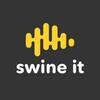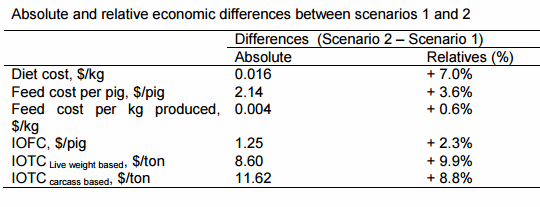There are multiple approaches a swine nutritionist can take in diet formulation: maximize performance, minimize cost, or maximize profit. Within each of these approaches, there are suboptions to decide from:
- Growth performance basis
- Maximize average daily gain (ADG)
- Minimize feed efficiency (F/G)
- Cost reduction basis
- Minimize cost per kg of diet
- Minimize feed cost per kg of gain
- Profit maximization basis
- Maximize income over feed cost (IOFC)
- Maximize income over feed and facility costs (IOFFC)
- Maximize income over total cost (live or carcass)
The value of body weight gain
An aspect that needs to be analyzed along with the options above, is if the production system runs mostly in a short in space or long space. For example, typically, during summer months when pigs have lower feed intake and, therefore, lower growth rate compared to other seasons, the production system will be short in space. Thus, each extra unit of body weight gain have added value because time is a constraint. On the other hand, during winter, when pigs have high feed intake and growth rate, the production system will be long in space.
Diluting fixed costs
A thorough economic analysis will take into account the dilution effect over the fixed costs from the added gain obtained through a given nutrition or management strategy. For instance, if a feeder pig costs $50 and we assume 100 kg gain during the finishing period, there will be a cost of $0.50 which is related to the fixed costs from the feeder pig (facilities, feed, vaccinations, labor, etc). A given strategy that increases body weight gain by 3 kg will yield a net gain during the finishing period of 103 kg instead of 100 kg. The $50 of the feeder pig will be diluted in 103 kg, thus the feeder pig cost per kg of gain is $0.485, which is a reduction of 3% in the cost of the feeder pig per kg produced. This approach can be used on a live or carcass basis, depending on the contract with the packer and if the strategy influences carcass characteristics (i.e., yield, lean, etc) or not.
Formulas
To calculate income per kg of live weight produced:
IOTCL = [market price per kg - ((1/market weight) x (feed cost per pig + other costs per pig + feeder pig cost))]
Or to calculate income per kg of carcass weight produced:
IOTCC = [market price per kg - ((1/market weight/% yield) x (feed cost per pig + other costs per pig + feeder pig cost))]
The following examples use these principles for comparison of a few specific scenarios and the impact on income over feed cost and income over total cost on a carcass basis:
Comparison of minimizing cost vs. maximizing profit per pig.
Diet cost should have manufacturing and delivery included and not just ingredient cost because this is a more accurate reflection of the cost of the feed consumed and the value of the performance differences.
Calculations
Scenario 1 (no added fat): 112 days x 0.816 ADG = 91.4 kg gain in the finishing
Feed cost per pig = 91.4 kg gain x 2.80 F/G x $0.229 feed cost/kg = $58.60
Scenario 2 (3% added fat): 112 days x 0.841 ADG = 94.2 kg gain in the finishing
Feed cost per pig = 94.2 kg gain x 2.632 F/G x $0.245 feed cost/kg = $60.74
In conclusion, the feed cost per pig in scenario 2 is $2.14 greater than scenario 1.
Thus, scenario 1 has the lowest feed per cost per pig;
However, in scenario 2 there are more kg produced per pig.
Thus, this needs to be taken into consideration: Considering the market pig price equal $1.21/kg and recalculating using IOFC:
Scenario 1:
IOFC (Sc1) = ($1.21 pig price/kg x 91.4 kg gain) – ($58.60 feed cost per pig) = $51.99 per pig IOFC (Sc2) = ($1.21 pig price/kg x 94.2 kg gain) – ($60.74 feed cost per pig) = $53.24 per pig
In conclusion, the income over feed cost per pig in the scenario 2 is $ 1.25 better than scenario 1, thus, adding fat in this scenario is more profitable.
Income over total cost
Assumptions
Carcass yield = 74% Carcass price = $1.65/kg
Feeder pig cost (22.7 kg) = $55
Other costs (facilities/transport/medicines/vaccines/slaughter) = $14.56 per pig
Calculations on a live basis
IOTCL sc1 = [$1.21- ((1/(22.7+91.4)) x ($58.60+$14.56+$55.0))] = $0.0868 per kg live weight produced
IOTCL sc2 =[$1.21- ((1/(22.7+94.2)) x ($60.74+$14.56+$55.0))] = $0.0954 per kg live weight produced
Scenario 2 (3% added fat) is 9.9% ($8.6/ton of live weight) more profitable than 1 (no added fat) in this market situation on a live basis.
Calculations on a carcass basis
IOTCL sc1 = [$1.65 - ((1/(22.7+91.4)/0.74) x ($58.60+$14.56+$55.0))] = $0.1321 per kg carcass weight produced
IOTCC sc2 = [$1.65 - ((1/(22.7+94.2)/0.74) x ($60.74+$14.56+$55.0))] = $0.1437 per kg carcass weight produced
Thus, scenario 2 (3% added fat) is 8.8% ($11.62/ton of carcass weight) more profitable than 1 (no added fat) in this simulation.
In conclusion, there are multiple strategies and approaches for diet formulation. It is important to use an approach that takes into account the value of performance (i.e., ADG, F/G, yield) but also the fixed time or fixed weight nature of the system. Therefore, using approaches such as income over feed (and facility) costs or income over total cost on a carcass basis are suitable solutions to robustly maximize the profitability of swine operations.
Presented at CLANA, Cancun, Mexico.










